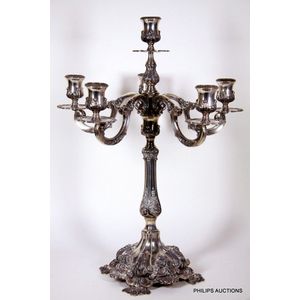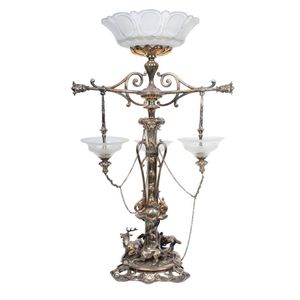EPNS Elkington Scalloped Glass Centrepiece with Hunting Scene Engraving
You must be a subscriber, and be logged in to view price and dealer details.
Subscribe Now to view actual auction price for this item
When you subscribe, you have the option of setting the currency in which to display prices to $Au, $US, $NZ or Stg.
- Scallop / Shell Motif - The shell motif has been used in furniture and decorative arts for centuries. In ancient Greece and Rome, shells were often used as decorative elements on furniture and in mosaics. The scallop or cockleshell are the most commonly used. During the Renaissance, the shell motif became popular in furniture and architecture, as the ornate decoration was seen as a symbol of wealth and luxury. In the 18th century, the Rococo style of furniture and decorative arts featured an abundance of shell motifs, and it was used by Thomas Chippendale and as a feature on Queen Anne style cabriole legs. In the 19th century, the shell motif was incorporated into Victorian furniture and decorative items, and often a representation of the the conch shell was inlaid into furniture.
- Ep / Epns - The abbreviation for electroplated and electroplated nickel silver, that is, silver plate.
The body of the piece is made of a common metal such as copper, and electroplating involves placing an extremely thin layer of silver on the surface of the piece. The resulting silver content is very small.
Unlike solid silver items, there is minimal underlying scrap value, and the value of such pieces is based on the quality, design and construction of the piece.
This item has been included into following indexes:
- centrepieces - silver plate items 129
- Elkington & Co. (England)
Visually similar items

Victorian silver plate centrepiece, c. 1900, with four cut crystal bowls. Height 45 cm. Provenance: The Estate of Nancy Melick, NSW

A sterling silver candelabrum, 20th century, with mark of Topazio, Portugal, of elaborate foliate form, the five armed candelabrum with scrolling arms and acanthus decorated sconces, a shaped slender baluster stem to a richly moulded base with leaf, scroll

A silver and gilt metal and opalescent glass six branch ceiling light, French, circa 1936. 90 cm drop, 86 cm wide

A pair of gilt metal gothic style candlestick lamps, French 19th century, 69 cm high
